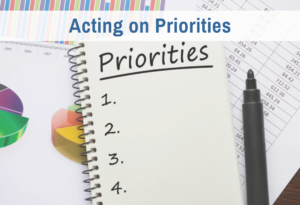Engineering your life is very much like engineering a suspension bridge. You start with a goal. To achieve the goal, you need to understand the fundamental forces you will work with, how to balance them to achieve your goal, and the nature of the materials used to balance them.
Gravity is the fundamental force you work with when building a suspension bridge. It is omnipresent. Every girder and cable is affected by it. All of the other forces — the tension in the cables, the friction that keeps the foundation in place — are calculated in relation to gravity.
Someone who has only a cartoon understanding of gravity might think that gravity is the problem that the bridge is designed to solve. If it weren’t for gravity, you could float across the river.
But of course, this is ridiculous. Gravity is an omnipresent fact that shapes every aspect of our world. Gravity creates the river by pulling water downhill. Gravity holds the atmosphere to the planet so we can breathe. Gravity keeps our planet close enough to the sun so that we can get the solar energy needed to sustain life. We wouldn’t be looking at the other side of the river, wanting a bridge, if it weren’t for gravity. This is what it means to say gravity is fundamental. Even the goal rests on gravity.
Gravity is not a problem; it’s a fact of nature. When you engineer a bridge, you don’t rail against gravity or any other fact. Rather, you cleverly consider how you could move things around and balance the forces to create a new structure that, based on all of the facts, will support heavy vehicles crossing the river quickly and safely.
The clever idea that underlies a suspension bridge is that cables can transfer all of the weight of the bridge to the towers that are on bedrock. In addition, the pull of the cables stabilizes the towers so they don’t fall over.
Of course, none of this works unless you use materials that are strong enough. The cables mustn’t break under the tension. The towers need to support the full weight without crumbling. The roadway should be strong enough so that it doesn’t collapse from its own weight or the weight of the vehicles.
When you engineer your life, the obvious issue you work with is motivation. You can’t take any action without motivation to act. We have two distinct systems that generate motivation. One generates impulses to avoid or eliminate threats; the other generates impulses to gain or keep values. They can easily be in conflict.
If you have only a vague understanding of motivation, you may think that the “wrong” motivation is the problem when you have trouble following through on your intended action. If it weren’t for the “wrong” motivation, you could just make yourself do the right thing.
Like gravity, motivation is not the problem. It’s a fact to be understood and worked around.
Unlike gravity, motivation is a man-made fact, not a fact of nature. It is the result of your past choices: your choices to think, to prioritize, and to act.
But at any given moment, motivation is a fact of your psychology. When you set a goal, you are not served by railing against your motivation or any other fact. Rather, you need to cleverly consider how you could make choices that, based on all of the facts including current facts about your psychology, will result in your achieving your goal.
Fortunately, we can learn clever ideas from other people. I doubt I would have ever come up with the design for a suspension bridge. Here’s the equivalent in psychology: The way you can make choices such that you manage your motivation to achieve the goal is that you adjust your process to create a virtuous cycle of success. You find some positive motivation for taking some small step that leads to some objective success, which in turn motivates the next step. This is a self-reinforcing loop that eventually leads to the goal.
Just as you need to vet the design of the bridge to make sure the materials are strong enough, you need to vet your virtuous cycle to ensure that you have sufficient knowledge, motivation, and skill to take a step and have it lead to an objective result. This takes self-understanding, and sometimes means you need to design your steps differently from the “obvious” way.
For example, it’s easy to get bogged down in preparation for a project. If you spend all of your time preparing but not doing, you eventually lose motivation. You’re better off to take a small step even if you’re not fully prepared. You need to get some real-world results to help see you are on the right track and get some true satisfaction from it.
This is the engineering approach to life. You treat all of the psychological obstacles as part of the challenge. By understanding how the mind works, you can use your creativity to break down the steps to ensure you achieve the goal one way or another. There may be some debugging involved but that’s okay. The thrill comes in creating the vision and figuring out how to make it happen in reality.









0 Comments